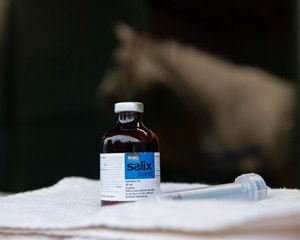Kentucky EDRC Opposes Changes to Race-Day Lasix Policy


Race-day Lasix was the center of conversation at the Oct. 28 Kentucky Drug and Research Council meeting, and the most controversial item of the day—phasing out Lasix in 2-year-olds and stakes races in Kentucky—was voted down 5-3 by the commitee, which makes medication rule recommendations to the Kentucky Horse Racing Commission.
The new rules on Lasix are supported by state tracks, as outlined in an Aug. 11 letter to KHRC general counsel John Forgy. Monday's meeting at the KHRC office in Lexington came only two days after animal rights activists protested across from Keeneland's main entrance on closing day, a fact not forgotten among those at the table.
The proposal considered by the EDRC, and outlined in the letter, was for 2-year-olds to run without race-day Lasix in 2020 and for the same rule to apply to all stakes horses in 2021. In April, Churchill Downs and Keeneland were among a coalition of tracks that announced they would be applying those same rules. The New York Racing Association, The Stronach Group, and Del Mar represent major racetrack operators that are also part of the coalition.
The Aug. 11 letter outlining sought rule changes including the Lasix policies also included Ellis Park, Kentucky Downs, and Turfway Park.
Multiple concerns were raised on equine safety regarding phasing out Lasix, including worries of an increase in horses bleeding on the racetrack, weakened pulmonary veins in a horse's lungs due to burst capillaries, and environmental factors such as dust and pollen that can irritate a horse's lungs.
After the motion failed, Sen. Damon Thayer, an EDRC member who supported the changes in Lasix policy, noted that the KHRC has precedent to vote on this item even though it failed to garner a recommendation from the EDRC. The EDRC recommends changes but the KHRC is not locked into following those recommendations.
"I think we should take the clear compromise and hope others follow," Thayer said, noting he would rather keep regulations at the state level instead of the national level. Thayer was speculating that inaction at the state level could open the door for added support of proposed federal legislation that would see the United States Anti-Doping Association take the lead on medication oversight for the sport throughout the U.S.
EDRC members Michael Kilgore, Johnny Mac Smith, Andy Roberts, James Morehead, and Marc Cheney voted against the item. All five are practicing racetrack veterinarians. Thayer, Churchill Downs executive Mike Ziegler, and veterinarian and EDRC chair Stuart Brown, voted for it. Art Zubrod, who represents Standardbred breeders on the committee, did not attend Monday's meeting.
While there's been talk of putting changes in place through track house rules, a 2015 opinion by the Kentucky Attorney General determined the KHRC acted beyond its authority when it allowed state tracks to offer races that would not allow race-day Lasix, by house rule. The tracks did find EDRC approval for other ideas.
The other three recommendations under racing medication were approved. The EDRC unanimously recommended extending the withdrawal time for non-steroidal anti-inflammatory drugs from 24 hours to 48 hours, and to eliminate the use of bisphosphonates in racing for horses 4-years-old and younger. Extending the withdrawal time for intra-articular corticosteroids from seven days to 14 days before a race passed 6-2. The EDRC will make those recommendations, which had the support of the tracks, to the KHRC.
In a move to help protect claiming horses, the EDRC unanimously passed a requirement that 14 days of medical records be provided at the time a horse is entered in a race. Those medical records can be seen after the claim is made. That change also was supported by the tracks.
Monday's meeting included a discussion on eliminating electronic therapeutic treatments on race day, including nebulizers, electric blankets, and magna wave treatment, to prevent altering the way a horse travels or masking lameness.
The item received seven affirmative votes to be recommended to the KHRC, and two votes with a motion to exclude nebulizers from the item.

In other news out of the meeting, scopolamine, the drug revealed last month to have been found in Justify after the 2018 Santa Anita Derby (G1), was recommended to be changed to Penalty Class C from Penalty Class B, in accordance with the Association of Racing Commissioners International. Penalty Class B calls for a trainer to be suspended 15-60 days, a $500-$1,000 fine, and a disqualification of the horse in absence of mitigating circumstance. Penalty Class C calls for lesser sanctions, though the ARCI notes a horse can still be disqualified.
The California Horse Racing Board did not disqualify Justify from his Santa Anita Derby win after it determined the lab finding was the result of environmental contamination. Scopolamine is found in the drug Buscopan, which is used to treat mild colic and spasms in equines, but it can also be found in horses that ingest jimson weed.
